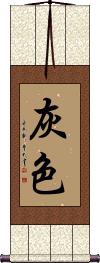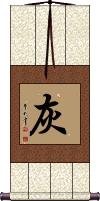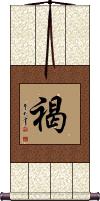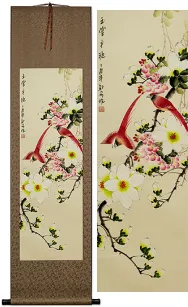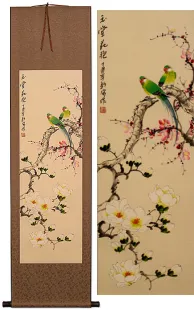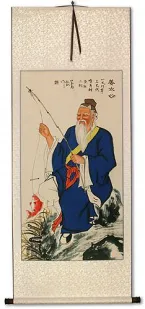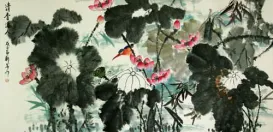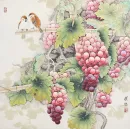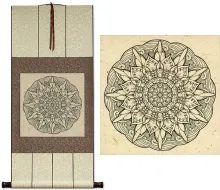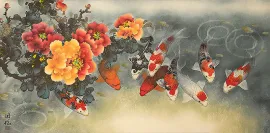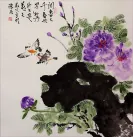Many custom options...
And formats...

Not what you want?
Try other similar-meaning words, fewer words, or just one word.
Gray Color in Chinese / Japanese...
Buy a Gray Color calligraphy wall scroll here!
Personalize your custom “Gray Color” project by clicking the button next to your favorite “Gray Color” title below...
Gray Color
灰色 is the Chinese, Japanese Kanji, and old Korean Hanja for the color gray.
This can also mean ash gray, grizzly, pessimistic, gloomy, dispirited, ambiguous (not black and white), and the alternate spelling grey.
Gray
Brown
Single character for brown color
褐 is the most simple way to express brown in Chinese.
It also means brown in Japanese but this character is not often written alone in Japanese (they would tend to write 褐色 (brown color) to refer to brown or the color of tanned skin.
In some contexts, this can refer to gray or a dark color, or coarse hemp cloth.
In the Buddhist context, it can refer to a coarse serge (cheaply sewn clothing) hence poverty.
Note: In Taiwanese Mandarin, this is spoken with the 2nd or rising tone instead of the 4th or falling tone used in the mainland.
This in-stock artwork might be what you are looking for, and ships right away...
Gallery Price: $72.00
Your Price: $39.88
Gallery Price: $120.00
Your Price: $49.88
Gallery Price: $72.00
Your Price: $39.88
Gallery Price: $108.00
Your Price: $59.88
Gallery Price: $108.00
Your Price: $59.88
Gallery Price: $340.00
Your Price: $188.88
Gallery Price: $200.00
Your Price: $69.88
Gallery Price: $286.00
Your Price: $158.88
Not the results for gray color that you were looking for?
Below are some entries from our dictionary that may match your gray color search...
| Characters If shown, 2nd row is Simp. Chinese |
Pronunciation Romanization |
Simple Dictionary Definition |
褐 see styles |
hè he4 ho kachi; katsu; kachin(ok) かち; かつ; かちん(ok) |
More info & calligraphy: Brown(1) (See 褐色) dark indigo (almost black); (2) coarse cloth Coarse serge, hence poverty. |
蒼 苍 see styles |
cāng cang1 ts`ang tsang souji / soji そうじ |
dark blue; deep green; ash-gray (n,adj-no,adj-na) (1) blue; (2) green; (3) (abbreviation) green light; (4) black (horse coat color); (prefix) (5) immature; unripe; young; (personal name) Souji Azure; the heavens; grey, old. |
溝鼠 see styles |
dobunezumi どぶねずみ |
(1) (kana only) brown rat (Rattus norvegicus); common rat; Norway rat; (2) dark grey (colour, color); dark gray; (3) secret evil-doer |
どぶ鼠 see styles |
dobunezumi どぶねずみ |
(1) (kana only) brown rat (Rattus norvegicus); common rat; Norway rat; (2) dark grey (colour, color); dark gray; (3) secret evil-doer |
ネズミ see styles |
nezumi ネズミ |
(1) (kana only) mouse; rat; (2) dark gray; dark grey; slate (color, colour) |
奶奶灰 see styles |
nǎi nai huī nai3 nai5 hui1 nai nai hui |
granny gray (hair color) |
星葦毛 see styles |
hoshiashige ほしあしげ |
(rare) (See 連銭葦毛) dapple gray (horse coat color); dapple grey |
灰汁色 see styles |
akuiro あくいろ |
(noun - becomes adjective with の) yellow-tinted gray (grey); scum colour (color) |
白葦毛 see styles |
shiraashige; shiroashige / shirashige; shiroashige しらあしげ; しろあしげ |
flea-bitten gray (horse coat color); flea-bitten grey |
虎葦毛 see styles |
toraashige / torashige とらあしげ |
(rare) (See 連銭葦毛) dapple gray (horse coat color); dapple grey |
黒葦毛 see styles |
kuroashige くろあしげ |
steel gray (horse coat color); steel grey |
連銭葦毛 see styles |
renzenashige れんぜんあしげ |
(noun - becomes adjective with の) (yoji) dapple gray (horse coat color); dapple grey |
ドブネズミ see styles |
dobunezumi ドブネズミ |
(1) (kana only) brown rat (Rattus norvegicus); common rat; Norway rat; (2) dark grey (colour, color); dark gray; (3) secret evil-doer |
Variations: |
dobunezumi; dobunezumi どぶねずみ; ドブネズミ |
(1) (kana only) brown rat (Rattus norvegicus); common rat; Norway rat; (2) (kana only) dark grey (colour, color); dark gray; (3) (kana only) underling; henchman |
Variations: |
nezumiiro(nezumi色, 鼠色); nezumiiro(nezumi色) / nezumiro(nezumi色, 鼠色); nezumiro(nezumi色) ねずみいろ(ねずみ色, 鼠色); ネズミいろ(ネズミ色) |
(noun - becomes adjective with の) dark gray; dark grey; slate (color, colour) |
Variations: |
aoi あおい |
(adjective) (1) blue; azure; (adjective) (2) (mostly archaic or in ref. to fruits, vegetables and traffic lights) green; (adjective) (3) (青い, 蒼い only) pale (facial color); gray; grey; (adjective) (4) (青い, 蒼い only) unripe; inexperienced |
The following table may be helpful for those studying Chinese or Japanese...
| Title | Characters | Romaji (Romanized Japanese) | Various forms of Romanized Chinese | |
| Gray Color | 灰色 | haiiro / hairo | huī sè / hui1 se4 / hui se / huise | |
| Gray | 灰 | kai | huī / hui1 / hui | |
| Brown | 褐 | katsu | hè / he4 / he | ho |
Successful Chinese Character and Japanese Kanji calligraphy searches within the last few hours...
